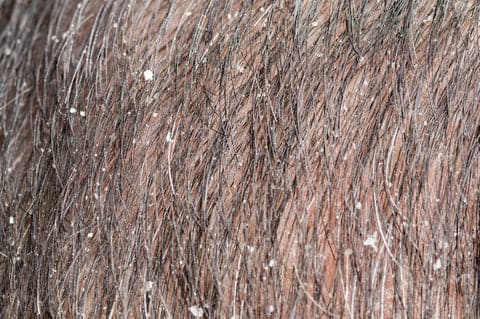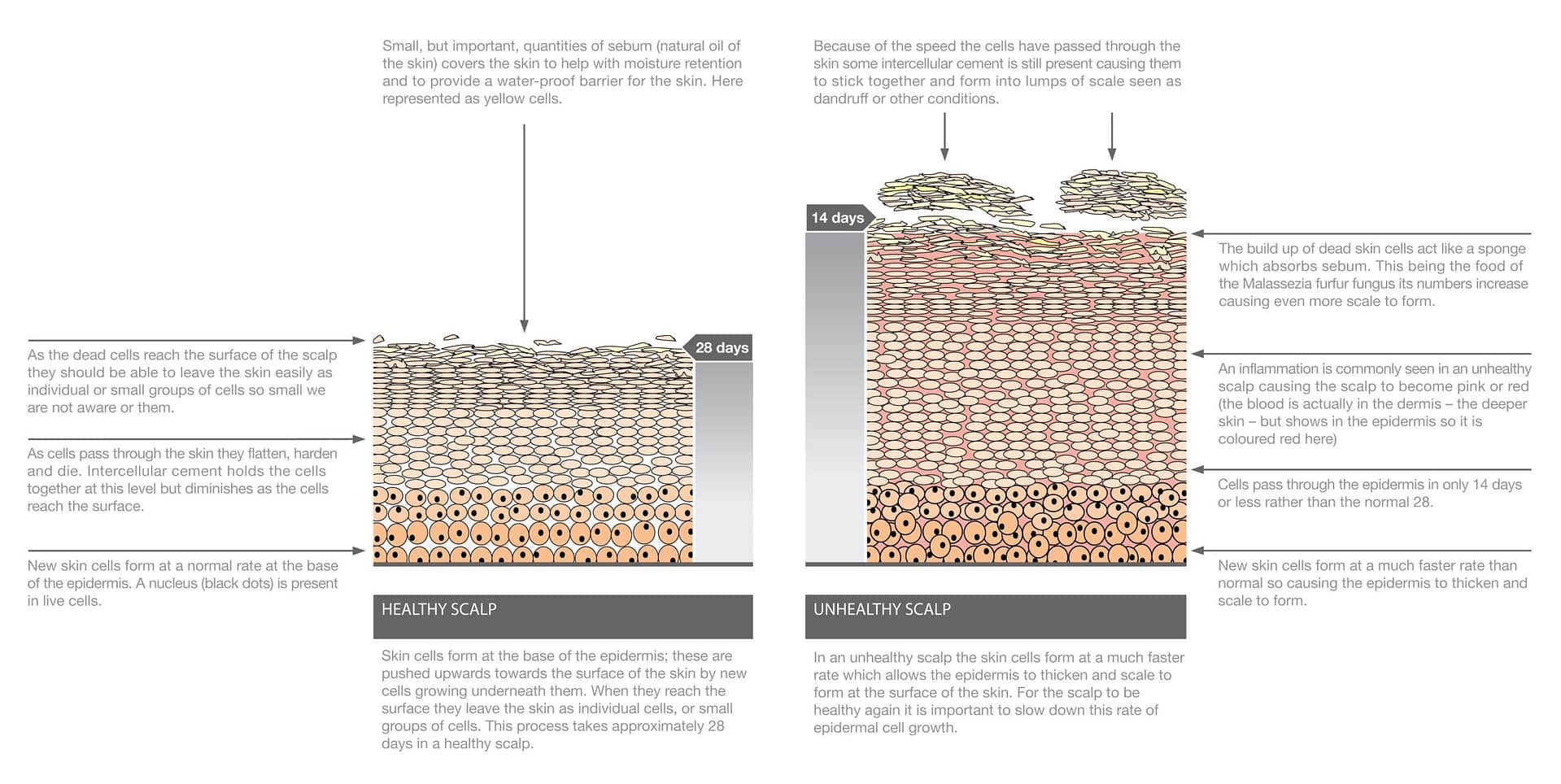
As discussed in previous blog posts, dandruff is not a ‘dry scalp’ Common dandruff (Pityriasis simplex) is caused by a reaction to an increase in the yeast, Malassezia globosa, which can always be found living on the scalp. There are many reasons for increased levels of this yeast, but a few of the most common triggers are stress, illness, and diet.
Seborrheic dermatitis, or Seborrheic eczema by its other name, is essentially a more severe form of dandruff, with the same or similar triggers. While dandruff causes an itchy, flakey scalp, that might appear like it’s a ‘dry scalp’, Seborrheic dermatitis causes a stronger, more inflammatory immune response that can leave the scalp extremely itchy and tender.

What happens within the skin when suffering from Seborrheic dermatitis?
Malassezia globosa, the native yeast on our scalp, feeds on sebum, the oil released from our sebaceous glands on each side of the hair follicle. When something triggers an increase in this yeast, the scalp’s micro-environment is affected, causing it to go out of balance. Sensing the problem, the body triggers an immune response that speeds up the epidermal turnover of the skin.
The epidermal turnover is the rate at which the skin cells grow from the base layer of the epidermis and move up to the surface of the skin. This process normally takes 28 to 30 days in normal, healthy skin. With Seborrheic dermatitis, the epidermal turnover can be 14 days or even faster.
The diagram below explains what happens to skin cells on your scalp when they pass through the epidermis at double speed.
Because skin cells have passed through the epidermis so fast, the intercellular cement that normally breaks down hasn’t had the opportunity to do so. It means old skin cells on the surface of the scalp do not break up and fall away from the scalp as they should. Instead, they clump together and help to form the larger flakes and plaques of skin that you notice with conditions such as seborrheic dermatitis and scalp psoriasis.
These larger flakes of skin absorb sebum on the scalp that is secreted from the sebaceous glands on each side of the hair follicle. This sebum is no longer moisturising the hair as it should, which is why bouts of seborrheic dermatitis can often have such a derogatory effect on the hair.
Even worse, the sebum now being soaked up by flakes on the scalp becomes the food-stuff of the Malassezia globosa yeast; as the yeast levels grow, inflammation increases & the condition worsens in a downward spiral.
How do you treat Seborrheic Dermatitis?
Controlling the levels of Malassezia globosa yeast
Most seborrheic dermatitis and anti-dandruff shampoos are designed to reduce and control the levels of Malassezia globosa yeast on the scalp. Many of the big brands use pharmaceutical ingredients such as Zinc Pyrithione and Ketoconazole, which are popular antifungals and generally work quite well at this task.
In the Juniper Scalp Therapy Shampoo, we use the pharmaceutical Piroctone Olamine. This antifungal works incredibly well at controlling Malassezia globosa and has also demonstrated a positive impact on the thickness of hair in clinical trials.
Besides Piroctone Olamine, the Juniper Scalp Shampoo uses powerful antimicrobial oils, including Juniper, Tea Tree, and Eucalyptus. These natural, therapeutic oils cleanse the scalp and also control levels of yeast.
Slowing the Epidermal Turnover & Reducing Inflammation
As we touched on above, the epidermal turnover can speed up to more than double the rate of healthy skin for those suffering from seborrheic dermatitis. Most standard Seborrheic dermatitis shampoos only look at reducing the yeast levels and cleansing the scalp. They do not include any ingredients that slow down the epidermal turnover. This should be a key function of any dandruff or seborrheic eczema shampoo.
The Juniper oil within the Juniper Scalp Therapy Shampoo, besides being a fantastic antimicrobial and anti-inflammatory, is an incredibly effective antimitotic. Mitosis is the process of skin cells multiplying. So an antimitotic slows down the formation of new skin cells – this is a vital process in calming and soothing over-active scalp tissues, allowing the epidermal turnover to return to a normal rate.
Besides Juniper Oil, our shampoo also contains excellent anti-inflammatory oils such as Thyme, Rosemary, Eucalyptus, and Tea Tree – these combine for additional relief from inflammation, helping to reduce redness and soreness.
An effective shampoo for Seborrheic dermatitis needs to do more than control the levels of yeast on the scalp. It needs to soothe and reduce inflammation, it should slow down the epidermal turnover, and it should clean and cleanse the scalp as gently, but effectively as possible. The Juniper Scalp Therapy Shampoo was clinically developed to treat severe scalp issues, and is recommended by Trichologists and Dermatologists in clinical practice across the UK.

